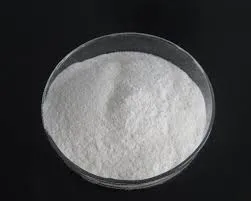
មករា . 01, 2025 16:22 Back to list
Understanding the Benefits and Applications of Redispersible Polymer Powders in Construction
The Role of Redispersible Polymers in Modern Construction Materials
Redispersible polymers have gained significant attention in the construction industry due to their versatile applications and contribution to enhancing the performance of building materials. These powdered polymers are typically used as additives in cement-based and gypsum-based formulations, improving properties like adhesion, flexibility, and water resistance. This article explores the function, benefits, and applications of redispersible polymers, shedding light on their importance in contemporary construction practices.
What are Redispersible Polymers?
Redispersible polymers are primarily produced through the process of spray-drying aqueous polymer emulsions. When mixed with water, they reconstitute back into a stable emulsion, allowing them to integrate seamlessly into various construction materials. Common types of redispersible polymers include ethylene-vinyl acetate (EVA), styrene-acrylic emulsion, and vinyl acetate-ethylene (VAE). The choice of polymer depends on the specific requirements of the application, such as desired mechanical properties and environmental conditions.
Enhancing Performance in Building Materials
One of the primary advantages of incorporating redispersible polymers into construction materials is the enhancement of mechanical properties. They contribute to improved adhesion between surfaces, making them ideal for use in tile adhesives, plasters, or thin-set mortars. The polymer’s film-forming capabilities allow for better bonding with substrates, ensuring durability and longevity in exterior applications where weather resistance is crucial.
Moreover, redispersible polymers improve the flexibility and crack resistance of construction materials. In regions prone to temperature fluctuations and seismic activity, these characteristics are essential in maintaining the integrity of structures. Polymers help absorb stresses that would otherwise lead to cracking, thereby extending the lifespan of the applied materials.
Water Resistance and Workability
In addition to mechanical enhancements, redispersible polymers provide significant improvements in water resistance. Their hydrophobic properties create a barrier against moisture ingress, which is vital in preventing damage due to water exposure. This is particularly important in applications like façade coatings, where maintaining a dry substrate is critical for preventing mold or structural degradation.
redispersible polymer

Workability is another area where redispersible polymers excel. They allow for easier application and manipulation of materials, whether in mortar mixes or coating products. The improved consistency also aids in achieving a better finish, which is essential in both aesthetic and functional aspects of construction.
Environmental Considerations
With increasing awareness of environmental sustainability, the construction industry is shifting towards greener alternatives. Redispersible polymers can play a crucial role in this transition. Many of these polymers are formulated to be low in volatile organic compounds (VOCs), making them safer for indoor applications and reducing the overall environmental impact.
Moreover, the ability to reduce water consumption in mixes contributes to more sustainable practices. Since redispersible polymers improve the workability and performance of materials, it is possible to achieve the desired properties without excessive water usage, aligning with contemporary environmental goals.
Applications in the Industry
The versatility of redispersible polymers allows them to be employed in a variety of applications, ranging from adhesives and sealants to flooring compounds and thermal insulation materials. In the tile adhesive market, for instance, their incorporation leads to better adhesion and flexibility, crucial for ensuring that tiles remain intact under various environmental conditions.
In decorative coatings, redispersible polymers not only enhance the adhesion to substrates but also improve the overall aesthetic quality by providing a smooth finish. In addition, in self-leveling compounds, they aid in flow and leveling properties, resulting in a more efficient installation process.
Conclusion
In conclusion, redispersible polymers are an invaluable asset to contemporary construction materials, offering significant enhancements in mechanical performance, water resistance, and workability. As the industry moves towards more sustainable practices, their low environmental impact further solidifies their position as a preferred additive in construction applications. With ongoing research and development, the versatility and functionality of redispersible polymers are likely to expand, presenting promising opportunities for innovation in the building materials sector. Embracing these materials not only leads to superior performance but also contributes to the overarching sustainability goals of the construction industry.
-
Versatile Hpmc Uses in Different Industries
NewsJun.19,2025
-
Redispersible Powder's Role in Enhancing Durability of Construction Products
NewsJun.19,2025
-
Hydroxyethyl Cellulose Applications Driving Green Industrial Processes
NewsJun.19,2025
-
Exploring Different Redispersible Polymer Powder
NewsJun.19,2025
-
Choosing the Right Mortar Bonding Agent
NewsJun.19,2025
-
Applications and Significance of China Hpmc in Modern Industries
NewsJun.19,2025







